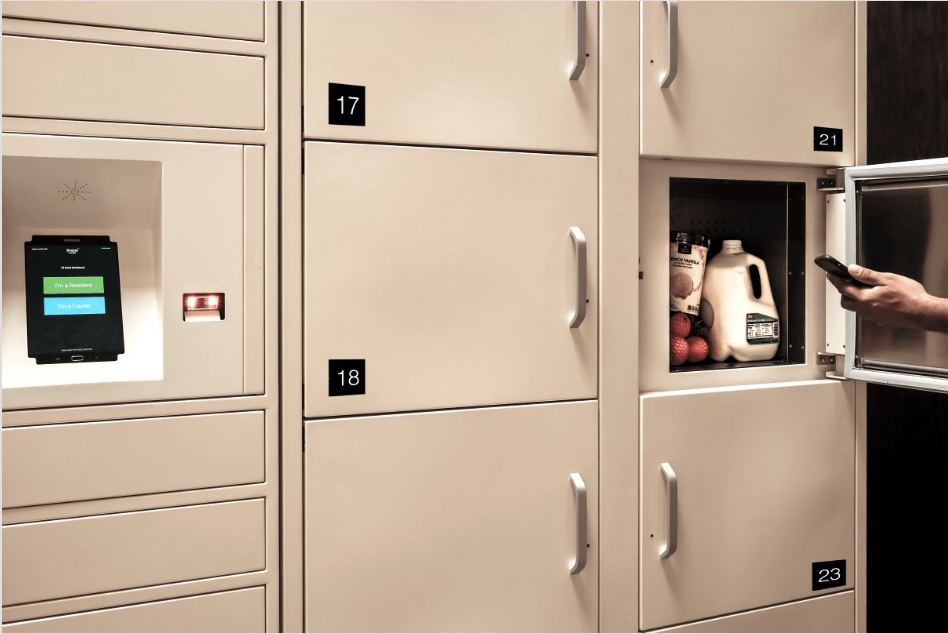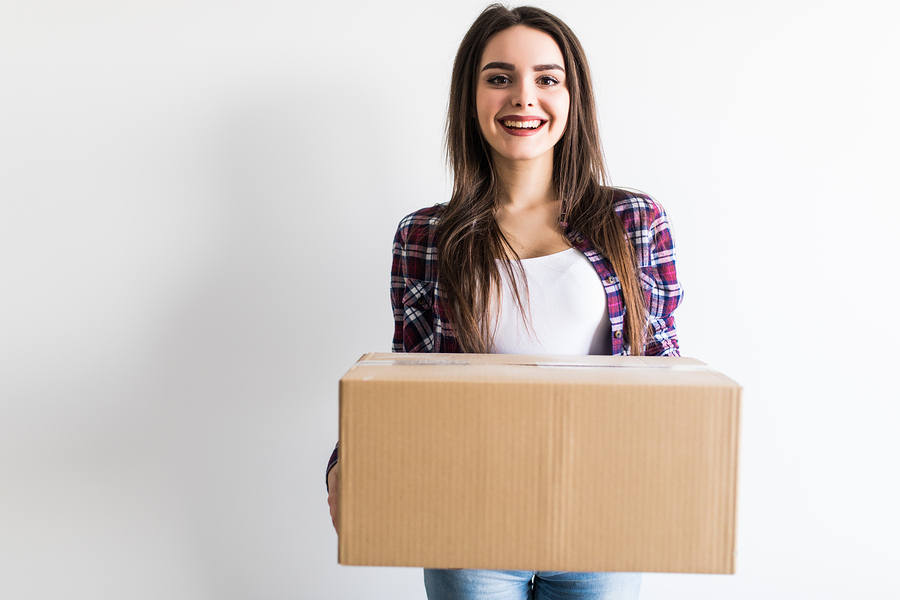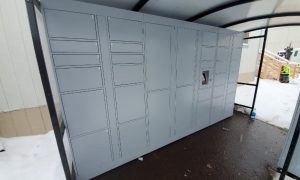Originally published in November, 2017.
Does any of this sound familiar?
You’re a property manager.
- Every day, boxes from Amazon, meal kits, grocery deliveries, and other packages flood your front office.
- Your staff spends hours logging deliveries and notifying residents their items have arrived.
- Residents complain that they can’t pick up their deliveries outside of regular office hours.
You run a click and collect system at a retail store.
- BOPIS customers get frustrated having to wait in long lines to pick up their orders.
- You have nowhere to store online grocery orders.
- Shoppers report a rocky in-store return process.
You’re an office manager.
- Employees take extra long breaks to go home and sign for high-value packages.
- Corporate and personal packages pile up on the receptionist desk.
- Workers are incessantly checking their phones tracking Amazon orders.
These are all common issues anywhere physical online orders cross the last yard of delivery — multifamily buildings, student housing facilities, retail stores with click and collect systems, corporate offices, and so on. And they’re likely to become even more prevalent as e-commerce continues to grow.
“Consumers spent $517.36 billion online with U.S. merchants in 2018, up 15.0% from $449.88 billion spent the year prior.” (Source)
Smart package lockers automate deliveries accurately and efficiently, taking the burden off the folks traditionally responsible for transferring packages into the right hands. This article describes how smart lockers work and why so many building managers and brand strategists are choosing them as their next value-added solution.
Why should you update your delivery methods?
Package delivery the old-fashioned way: Pen and paper
You’re probably well-acquainted with the old-fashioned way of managing package deliveries.
A delivery driver arrives with 10 or 20 or 200 packages, dropping them inside the door in the back room. Then, a front desk worker manually logs the deliveries, scoots parcels around so they’re out of the way, and spends an hour or so sending package notifications via email or text.
Later that day, or the next day, or three weeks down the road, a tenant shows up to collect their package, and a staff member has to dig through the pile of packages to find the right one.
There are many problems with this system:
- Sometimes no one is at the front desk when the delivery driver arrives, so couriers just plop packages down anywhere.
- Sometimes workers don’t send delivery notifications, so residents don’t know they have a package waiting.
- Sometimes residents never pick up their packages, so boxes accumulate until the annual clean-out-the-back-room day rolls around.
- Sometimes the contents of the packages are perishable, and, left unattended, things can get a little gross.
Manually logging deliveries isn’t an ideal, and with everyone’s desire for instant gratification (thanks, free, two-day shipping), the old-fashioned way of handling deliveries won’t cut it.
E-commerce order fulfillment of the past: Slow, unsecured deliveries
Until recently, online retailers could get away with offering shipping that moved at a snail’s pace, and at the customer’s expense no less.
Think back to online shopping five years ago. A customer would select their items online, pay for shipping no matter what, check out, and expect a courier to leave their order on the front porch, unattended, in 7-10 business days. Retailers that still adhere to these kinds of e-commerce strategies (if they’re even still around) will run into serious customer satisfaction issues.
- Customers expect free shipping, even for lower-value items.
- As for two-day shipping? Four in ten shoppers don’t want to pay for that, either.
- Most customers aware of click and collect delivery services have tried it, with their #1 reason being to avoid shipping costs.
- One in four customers have had a package stolen, and half of people know someone who has.
For retailers to survive in this competitive e-commerce market, they need to give people what they want — free, fast fulfillment — in a secure fashion.
Package delivery of the future: Smart package lockers
The problems described above are why innovative companies like Silicon Valley-based Smiota developed smart package lockers powered by cloud-based automation software.
- Smart lockers. Smart lockers allow delivery drivers to deposit packages and recipients to pick up packages 24/7. Smiota’s locker banks can accommodate packages of any size, and can also accommodate grocery, meal kits, and pharmaceutical deliveries in their refrigerated and frozen locker options. Best of all, the entire delivery process is automated — the system sends a notification via text or email to the package recipient and tracks the package from delivery to pick up.
Related reading: The Ultimate Guide to Smiota Smart Lockers
Smiota also offers package management software designed for multifamily and corporate buildings that want to secure their now-outdated mailrooms and keep full chain of custody records.
- Mailroom software. For buildings that aren’t ready for smart lockers, package management software is a tool that mailroom staff can use to receive packages, send notifications, and release packages to tenants using just a smartphone.
Both of these systems leverage cutting-edge technology to secure the last yard of delivery.
- The courier or worker scans and deposits a package in a locker or the mailroom.
- The software automatically sends the package recipient a phone notification.
- The package recipient uses a unique password or the mobile app to gain entry to the locker or mailroom.
- The system collects and retains full chain of custody records that administrators can access at any time.
It’s that easy! And smart lockers have many other benefits as well. Let’s take a closer look.
Benefits of smart lockers: Security
The old-fashioned approach to package delivery isn’t efficient, let alone secure. Smart lockers provide protection and traceability from the moment a package is placed in a locker to the moment the recipient picks it up.
Challenge #1: Theft
Package theft can happen to anyone, especially when couriers deliver parcels outside front doors or to unattended desks. Smiota CEO Manju Kashi fell victim to package theft, inspiring him to create a solution.
Package delivery rates are increasing every year. In fact, USPS shipped an impressive 6.2 billion packages in 2018, up 8.8% from 2017. More packages mean increased vulnerability to theft. Facilities that don’t have surveillance or a secure spot to place packages are especially at risk.
Smart lockers stop thieves in their tracks.
Challenge #2: Complete chain of custody
A complete chain of custody allows you to track orders back to their source. This is especially useful if something goes wrong and a package is misplaced (which, according to one former USPS employee, happens about 1% of the time, 2% during high-volume times like holiday season). Unfortunately, in most cases, the chain of custody stops the moment a package is dropped at the front desk or on someone’s porch.
Think about this issue at an apartment complex. Even if someone writes down when packages are delivered and picked up, there are limitations to keeping accurate chain of custody records. What if the recipient scoops up a delivery while the front desk staff is on lunch? What if the receptionist makes a human mistake (gasp!) and forgets to write something down?
While you may not be handling top-secret documentation or forensic evidence (or maybe you are!), a complete chain of custody is critical to building trust with your network and protecting your credibility.
Benefits of smart lockers: Efficiency
With the digital age comes a higher demand for efficiency. And traditional order fulfillment and delivery methods are, in a word, inefficient.
Challenge #1: Staffing (or lack thereof)
Most buildings and stores don’t have staff members dedicated to managing packages or a click and collect system. They have apartment managers, leasing agents, customer service managers, and sales associates. Delivery management duties usually fall to one or more of these staff members, which means they spend a lot of time during the week doing tasks outside of their primary responsibilities.
Salaries for personnel like this that can easily surpass $40K. Can you afford to have your team spending time outside their regular duties?
A package delivery system frees up your staff’s time so they can focus on higher-value tasks, like showing apartments and interacting with customers. It also allows people to pick up their packages at any time, so you don’t have to hire an extra staff member or pay overtime.
Challenge #2: Keeping up with orders and deliveries
E-commerce is taking off like gangbusters as retail giants offer fast, free shipping, the popularity of subscription boxes explodes, and people take advantage of click and collecting fresh groceries. With so many consumers enjoying the convenience of having everything shipped directly to them or skipping the checkout line in-store, more people are paying attention to the last yard of delivery than ever before.
And don’t forget holiday pandemonium. Imagine this:
Your 150-unit downtown Denver apartment building is at 90% occupancy. From the conversations you’ve had with your tenants, you know they’re scrambling to get ready for the holidays. You recommend your favorite places to shop, and at least half of your recommendations are online retailers.
Your tenants take your advice, and the week before Christmas you end up with 25 additional packages coming through the door each day. The situation can conservatively be described as chaos.
And on the other end of the transaction — the retail side — things can get equally as crazy. Holiday shoppers in 2018 click and collected 47% more than in 2017. Without some automation, in-store order fulfillment can be a major pain for both retailers and customers.
The bottom line? Managing the chaos can be incredibly time-consuming and frustrating. And people aren’t exactly known for having extra patience around the holidays.
A smart package delivery system removes this entire burden from your plate and ensures everyone knows their orders are stored securely and ready for pickup.
Related reading: Unbeatable Benefits of Smart Package Lockers for Retail Stores
Challenge #3: Measuring productivity wins
Metrics are the only way to know if new systems, practices, or policies are working. When it comes to package delivery or BOPIS order fulfillment, you might be left scratching your head. How do you know if your system is working, or, more importantly, if it’s not?
Smart lockers are powered by cloud-based software, so you have access to admin tools that can give you visibility into your operations and help boost your productivity. For example, on Smiota’s admin web app, you can:
- See your history of packages received and picked-up
- Open lockers
- Manage overdue pickups
- Remind recipients to pick up overdue packages
It’s tools like this that give smart lockers a competitive advantage over manual package management.
Benefits of smart lockers: Value-added for end users
To compete in today’s marketplace, upgrading your facilities with new amenities and technologies isn’t optional.
Challenge #1: Retaining and attracting tenants and customers
Getting the right people into your space (and enticing them to stay) is an ongoing challenge for any business.
Take multifamily as an example. Apartment tours can have potential tenants completely blown away, impatiently asking “When can I move in?” Or on the flipside, apartment seekers can sign off with a flat, “This could work…”? Offering value-added amenities like smart lockers can be the difference.
In the retail world, think about the impression you’re making on your customers. Are they thrilled with how quick and efficient your BOPIS system is, even taking extra time to shop for more? Or are they taking to Twitter to complain about long lines? Again, you could be looking at the difference between a store with smart lockers vs. one without.
Challenge #2: Keeping up with shopping trends
Ipsy. Blue Apron. Barkbox. Click and collect. Free shipping. Fast shipping. Shipping from Costco?!
The right package delivery system will help you keep up with these trends. For example, Smiota’s refrigerated smart lockers offer a solution for the meal kit and grocery click and collect trend. The lockers are completely temperature-controlled, so people can feel secure about the freshness of their food.
Modern delivery systems also make oversized packages no problem. Smart lockers come in various sizes, so they can accommodate that bulk order of laundry soap that was just too good of a deal to resist.
Choosing a package delivery system
Now that you know the main benefits of smart lockers, let’s look at how to choose the right system. Here’s what our customers tell us are the most important features of Smiota:
- Ease of use: Whenever you introduce new technology, it’s paramount that it’s easy to use and adapt to. When choosing a package delivery system, consider how easy it will be for the couriers, administrators, and end users. Also, make sure you’re getting the level of customer service support you need.
- Security: With smart lockers, packages are placed in a locker that only the courier, recipient, and in some cases, the admin can open. With secure mailroom software, it’s easy to lock down your deliveries with security cameras inside and outside the room.
- Smartphone integrations: From the end user’s point of view, being able to access delivery information on your smartphone is a must. Most package management systems offer text message notifications. Smiota goes a step further. The iOS and Android app alerts recipients as soon as their packages are dropped in the locker and allows them to open the door directly from their phone.
- No attendant necessary: Not all package delivery systems can go unattended 100% of the time. Choosing smart lockers that stand alone eliminates the time and money it takes to train someone else how to attend to it.
- Refrigerated and frozen lockers: Grocery delivery and in-store pickup is gaining traction, and you need to be prepared. Installing temperature-controlled lockers will help you get ahead of the trend.
- Pricing: This is our customers’ paramount concern. Package lockers are an investment, but a worthy one. If you crunch the numbers, you’ll conclude that the cost of lockers is significantly less than hiring another person to do what lockers can do automatically.
Related reading: Why Choose Smiota Package Management System?
—
Ready to get started with smart lockers? Contact us today!






